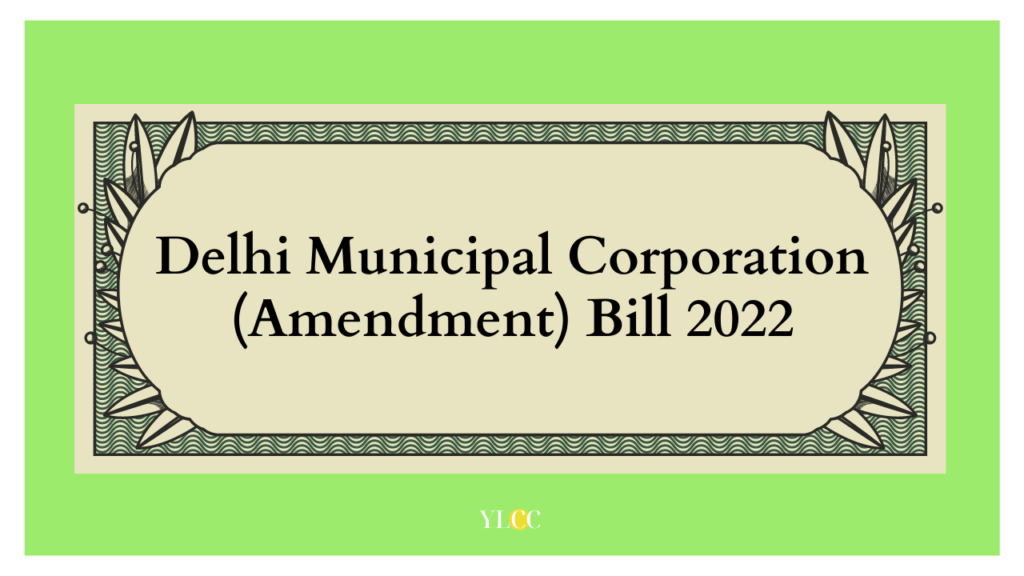
Municipal Corporation of Delhi is the municipal corporation that governs most of Delhi, India. Currently, the MCD is among the largest municipal bodies in the world providing civic services to an estimated population of more than 11 million citizens in the capital city.
One of the major legislative developments this year has come in the form of the Delhi Municipal Corporation (Amendment) Bill, 2022.
In this article, Team YLCC explains all you need to know about this Bill. Read on!
BACKGROUND OF THE NEW BILL
The trifurcation of the Municipal Corporation of Delhi (MCD) into South Delhi, North Delhi and East Delhi was introduced in 2011 by the then Delhi Chief Minister Sheila Dikshit. Over the years, this change has not paid rich dividends, and has in fact brought to the fore several issues which the new Bill seeks to address. By removing the Delhi government from a position of power for any sort of intervention in the affairs of the civic bodies, the Delhi Municipal Corporation (Amendment) Bill 2022 proposes to make the unified municipal agency dependent solely on central government for funds.
HIGHLIGHTS OF THE BILL
- The first and major highlight of the Bill is that it seeks to unify the three existing Municipal Corporations into a single Municipal Corporation of Delhi. This would thereby undo the trifurcation that was introduced and implemented through the 2011 Amendment. All the liabilities, employees, revenue sources of the SDMC, EDMC and NDMC will soon thereafter be transferred to the MCD. All properties, movable and immovable, of or belonging to the erstwhile corporations shall vest in the Municipal Corporation of Delhi.
- The bill proposes to substitute the word “government” with the word “central government” in several provisions in the existing law. Through the 2011 Amendment, significant powers were placed with the Delhi government. The new Bill seeks to place these powers once again with the Central Government. These powers include deciding the number of seats of councillors and the number of seats reserved, division of the area of corporations into zones and wards, delimitation of wards, matters such as salary and allowances of MCD employees, the issue of leaves of the Commissioner, sanctioning of the consolidation of loans by a corporation and sanctioning suits for compensation against the Commissioner for the loss or waste or misapplication of Municipal Fund or property. Similarly the Bill also takes away the Commissioner’s power with respect to building regulations under the general superintendence and directions of the Delhi Government and instead vests it with the Central Government.
- The existing law prior to the introduction and passage of this bill provided that the number of seats in the three corporations together shall not exceed 272. In accordance to this, the 14th Schedule to the 2011 Act specifies 272 wards across the 3 Municipal Corporations. The new Bill states that the total number of seats in the newly formed Municipal Corporation of Delhi should not be more than 250, thereby reducing the number of wards and councillors.
- The new Bill seeks to remove the Director of Local Bodies as was provided in the existing law wherein the Director of Local Bodies had the responsibility of coordinating between Corporations, framing recruitment Rules for hiring new employees, coordinating the collection and division of toll tax collected by the respective Corporations. Needless to say, the merger of all 3 civic bodies means that this position has been rendered redundant.
- The new Bill provides for the appointment of a Special Officer by the Central Government in order to exercise the powers of the Corporation until the time that the first meeting of the Corporation is held after the commencement of the Bill.
- The newly formed Municipal Corporation of Delhi has been also assigned the responsibility of setting up an E-governance system for citizen services through which better, accountable and more transparent services can be provided to citizens from the comfort of their homes.
WHAT WAS THE NEED FOR THE UNIFICATION OF THE CIVIC BODIES?
- First of all, the existence of a trifurcated MCD system faced multiple problems over the years, especially when it came to employee management. There were consistent issues regarding non-payment of salaries of sweepers and other sanitary workers, uneven distribution of property tax between the three civic bodies, inefficient management and growing operational losses, etc. which mandated a newer and more effective approach.
- One of the major issues with the existing system was the operation of multiple decision-making bodies in a single city of Delhi which was considered as a Union Territory. This included three Municipal Corporations, New Delhi Municipal Corporation (NDMC) as well as the Delhi Cantonment Board. The multiplicity of decision-making bodies made the proper implementation of Central Government schemes a significant challenge as every single decision had to pass through multiple channels of approval.
- There is a growing issue of backlog within the MCD structure. In the last year, the pending workload has increased manifold and continues to grow. With the new law, the executive aims to streamline the administrative processes aimed at bringing down the backlog of work.
- The main reason behind introducing this bill was to minimise the MCD expenses which were high skyrocketing due to the existence of three separate civic bodies, each having their own Commissioners, Additional Commissioners and different Committees. Currently once the South MCD can sustain itself financially while the North and East MCDs are both clocking high losses. Over the years, this has snowballed into a massive financial crisis and the new Bill seeks to bring down the costs significantly.
LEGALITY OF THE BILL
The proposed law has been drafted by the Centre banking on its power under clause (c) of sub-section 3 of Article 239AA. Article 239AA was inserted in the Constitution in 1991, mandating an elected government in the national capital with a legislative assembly of its own.
The clause empowers the central government to enact a law with respect to the same matter on which the legislative assembly has already framed a legislation. This constitutional provision authorises Parliament to add to, amend, vary, or even repeal the law so made by the legislative assembly by making a law subsequently. In NDMC Vs State of Punjab (1996), the Supreme Court cited sub-section 3 of Article 239AA to hold that “the plenary power to legislate upon matters affecting Delhi still vests with Parliament as it retains the power to legislate upon any matter relating to Delhi and, in the event of any repugnancy, it is the parliamentary law which will prevail”.
While the letters of the law give an upper hand to the central government, the purposive interpretation of Article 239AA by the Supreme Court has recently underscored how Delhi is different from every other UT and is in “a class by itself” and that the principles of democracy and federalism must be reinforced in NCT of Delhi in their truest sense. In addition to this, the Supreme Court was emphatic in ruling that the exercise of establishing a democratic and representative form of government for NCT of Delhi by insertion of Articles 239AA would turn futile if the Government of Delhi, which enjoys the confidence of the people of Delhi is not able to usher in policies and laws over which the Delhi Legislative Assembly has power to legislate for the NCT of Delhi.
Update: The Bill was passed by the Lok Sabha on March 30 and by the Rajya Sabha on April 5, 2022. On April 18, the Bill received assent from the then President Ram Nath Kovind and it currently functions as a statute.
YLCC would like to thank its Content Team for their valuable insights in this article.






